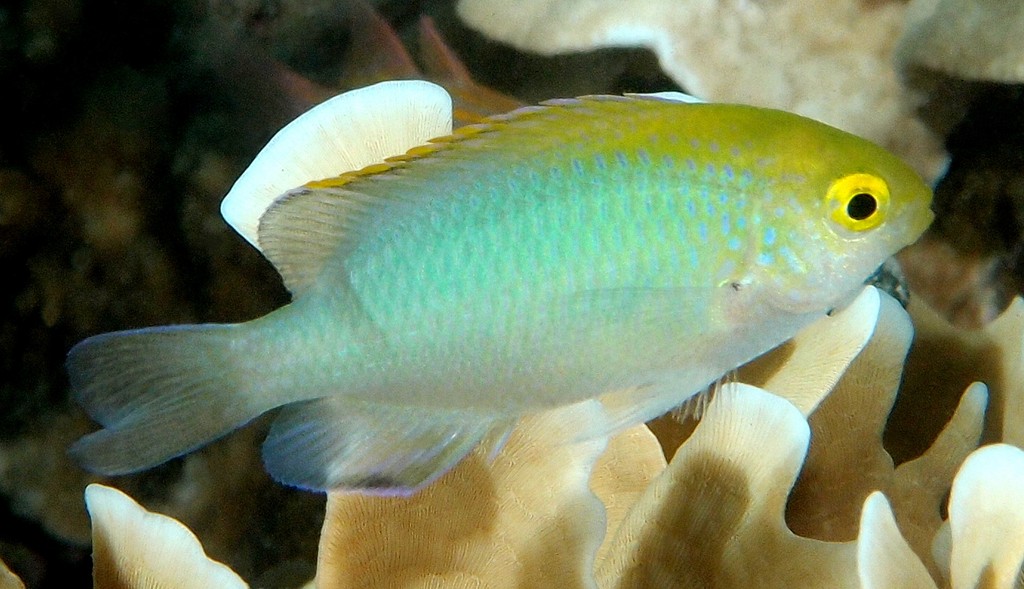POMACENTRUS AURIFRONS - (ALLEN, 2004)
Actinopterygii (Gigaclass) > Actinopteri (Class) > Teleostei (Subclass) > Blenniiformes (Order) > Pomacentridae (Family) > Pomacentrinae (Subfamily) > Pomacentrus (Genus)
Demoiselle à tête jaune, Yellowhead damselfish, Goldhead Damsel,
Description
Dorsal spines (total): 13; Dorsal soft rays (total): 12; Anal spines: 2; Anal soft rays: 13; Pectoral fin rays: 16-17; Tubed lateral-line scales: 14-17; Gill rakers: 6-7 + 12-15 (total: 19-22); Body depth: 1.9-2.1 in SL. Max. length: 6.2 cm SL. Depth range: 2 - 14 m.
Color
Etymology
Pomacentrus: from Greek, poma, -atos = cover, operculum + from Greek, kentron = something with a sharp point: point, spike, spur, sting, quill, thorn. Referring to serrations and prickles along margins of opercular bones of Pomacentrus pavo.
aurifrons: from Latin, auri = gold + from Latin, frons = forehead, in reference to the characteristic yellow marking on the forehead.
Original description: Pomacentrus aurifrons Allen, 2004 - Type locality: Toiyama Island, Amphlett Group, Milne Bay Province, Papua New Guinea (9°18.909'S, 150°51.100'E), depth 12 meters.
Demoiselle à tête jaune, Yellowhead damselfish, Goldhead Damsel,
Description
Dorsal spines (total): 13; Dorsal soft rays (total): 12; Anal spines: 2; Anal soft rays: 13; Pectoral fin rays: 16-17; Tubed lateral-line scales: 14-17; Gill rakers: 6-7 + 12-15 (total: 19-22); Body depth: 1.9-2.1 in SL. Max. length: 6.2 cm SL. Depth range: 2 - 14 m.
Color
Pale grey to nearly white with blue spot on head scales, vertically elongate, blue streak on most body scales, broad zone of yellow encompassing snout, forehead, and base of anterior dorsal spines, translucent fins with bluish dorsal, anal, and caudal soft rays, and narrow yellow margin on spinous dorsal fin.
Etymology
Pomacentrus: from Greek, poma, -atos = cover, operculum + from Greek, kentron = something with a sharp point: point, spike, spur, sting, quill, thorn. Referring to serrations and prickles along margins of opercular bones of Pomacentrus pavo.
aurifrons: from Latin, auri = gold + from Latin, frons = forehead, in reference to the characteristic yellow marking on the forehead.
Original description: Pomacentrus aurifrons Allen, 2004 - Type locality: Toiyama Island, Amphlett Group, Milne Bay Province, Papua New Guinea (9°18.909'S, 150°51.100'E), depth 12 meters.
Distribution
Western Pacific: Papua New Guinea to Solomon Islands, Vanuatu and New Caledonia.
Western Pacific: Papua New Guinea to Solomon Islands, Vanuatu and New Caledonia.
Biology
Adults are common on coastal fringing reefs and offshore platform reefs. Found in groups above coral. Feed on zooplankton. Oviparous, distinct pairing during breeding. Eggs are demersal and adhere to the substrate. Males guard and aerate the eggs.
Adults are common on coastal fringing reefs and offshore platform reefs. Found in groups above coral. Feed on zooplankton. Oviparous, distinct pairing during breeding. Eggs are demersal and adhere to the substrate. Males guard and aerate the eggs.
Similar species
Pomacentrus smithi (Fowler & Bean, 1928) - Reported from Indonesia to Philippines - These species have similar morphology but are easily distinguished by the size of the dorsal fin and colour pattern differences, particularly the broad zone of yellow encompassing the snout, forehead, and base of the anterior dorsal spines. Pomacentrus aurifrons have a taller dorsal fin than Pomacentrus smithi (tallest dorsal ray averaging 1.37 in HL versus 1.65 in HL for Pomacentrus smithi).
Pomacentrus smithi (Fowler & Bean, 1928) - Reported from Indonesia to Philippines - These species have similar morphology but are easily distinguished by the size of the dorsal fin and colour pattern differences, particularly the broad zone of yellow encompassing the snout, forehead, and base of the anterior dorsal spines. Pomacentrus aurifrons have a taller dorsal fin than Pomacentrus smithi (tallest dorsal ray averaging 1.37 in HL versus 1.65 in HL for Pomacentrus smithi).
